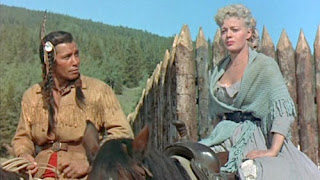Directed by Fritz Lang; produced by Seton I. Miller
A man (Ray Milland), just released from a mental institution, passes the time waiting for his train by taking in a village fête. There he correctly guesses the weight of a cake, thanks to a clue given by a fortune-teller. His new pastry is immediately the goal of several attempts at theft, and he quickly realises that he has stumbled into a plot laid by criminals.
Ministry of Fear falls into a sub-category of adventure film in which ordinary people get caught up in intrigue and action, usually due to unwittingly possessing something that nefarious parties want. There are better examples, such The 39 Steps or The Lady Vanishes, but Ministry of Fear nonetheless provides fun entertainment. Milland is a solid choice for the leading man, stalwart and not one to be pushed around, but with a hint of vulnerability, due to his past. The acting from everyone is good; as is often the case, the supporting performers can lend invaluable support (or ruin an otherwise good film) and here Percy Waram as a gloomy police inspector and Hillary Brooke as an beautiful medium stand out. Strangely, Dan Duryea is wasted in a small role that anyone could have played.
The principal problem is, I think, the script. The story, from a Graham Greene novel, is involving, with aliases and hidden identities all over the place. But it still comes off as rather light. Enemy spies are after something hidden in Milland’s prize cake, but why hide anything in a cake? It’s not as if the cake were being smuggled to Germany; it was simply to be passed from one person not under surveillance to another.
Milland’s character is initially incarcerated for the mercy-killing of his wife. But except for the opening scene and that of a séance, its effects are not really important. Time and clocks figure prominently at first but, like the occult, are not referred to much afterward. I could not help thinking that these themes could have been used for added tension.
The relationship between Milland and his love-interest (Marjorie Reynolds) develops far too fast for credibility. A superior example of time being taken in creating a relationship - producing suspense in romance to parallel that in action - may be found in the aforementioned The 39 Steps. Motivation is also not explored in the villains. More than one is a refugee from Nazi tyranny, yet we are not told if they were imposters all along, if blackmail or pressure was used, etc. Characters are slender in Ministry of Fear.
All that written, there is no denying that the movie is enjoyable. Fun and fast-paced, it may be less successful than some, but is undeniably more entertaining than many. Like Milland’s cake, Ministry of Fear is light, looks good and is tasty, if not quite as filling as one would like.
























